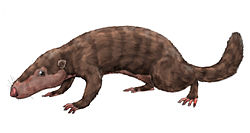- Morganucodon
-
Morganucodon
Temporal range: Late Triassic to Early Jurassic
Restoration of M. watsoni Scientific classification Kingdom: Animalia Phylum: Chordata Subphylum: Vertebrata (unranked): Amniota Class: Mammalia sensu lato Order: Morganucodonta Family: Morganucodontidae Genus: Morganucodon
Kühne, 1949species - M. oehleri
- M. watsoni
Morganucodon ("Glamorgan tooth") is an early mammalian genus which lived during the Late Triassic. It first appeared about 205 million years ago. This has also been identified with Eozostrodon.[1] Unlike many other early mammals, Morganucodon is well represented by abundant and well preserved, though in the vast majority of cases disarticulated, material. Most of this comes from Glamorgan in Wales (Morganucodon watsoni), but fossils have also been found in the Yunnan Province in China (Morganucodon oehleri), in various parts of Europe and North America and some at least closely related animals (Megazostrodon) are known from exquisite fossils from South Africa.[2]
The name is often stated to mean "Morgan's tooth", but that would be Morganodon in Greek. Rather, it comes from a Latinization of Morganuc, "South Glamorgan in Domesday Book", the county where it was discovered by Walter Georg Kühne,[3] so it means "Glamorgan tooth". It has acquired the nickname Morgie in the Smithsonian National Museum of Natural History.[4]
Contents
Morganucodon in life
Like most of the early mammals, Morganucodon was a small, furry, plantigrade animal. The tail was moderately long. According to Kemp (2005) "the skull was 2-3 cm in length and a presacral body length of about 10 cm [4 inches]. In general appearance it would have looked like a shrew or mouse".[5]
Morganucodon was likely nocturnal, and spent the day in a burrow. The diet appears to have been insects and other small animals, again much like a modern shrew. Being older than the appearance of the marsupial and placental mammals, it likely laid eggs.
Classification
One classification[6] of the close relatives (all extinct, variously from Late Triassic to Middle Jurassic) is:
- Order Morganucodonta
- Family Morganucodontidae
- Genus Morganucodon
- Genus Eozostrodon
- Genus Brachyzostrodon
- Genus Helvetiodon
- Genus Erythrotherium
- Genus Wareolestes
- Family Morganucodontidae
Mammal or "pre-mammal"?
There has been a long controversy about whether or not to classify it as a mammal at all and some authors prefer to include it in a broader clade called Mammaliaformes. Morganucodon is regarded as very primitive, for its lower jaw retains some of the bones found in its reptilian ancestors in a very reduced form, rather than being composed solely of the dentary. Furthermore, the primitive reptilian jaw joint between the articular and quadrate bones, which in modern mammals has moved into the middle ear and become part of the ear ossicles as malleus and incus, is still to be found in Morganucodon.[7]
However, a consensus accepted by most scientists states that mammals as a group are defined by the possession of a special, secondarily evolved jaw joint between the dentary and the squamosal bones, which has replaced the primitive reptilian one between the articular and quadrate bones in all modern mammalian groups. Morganucodon is special in this respect, because apart from still having the primitive hinge, it has also evolved the derived mammalian one and thus features a double jaw joint. More interestingly from a paleoecological point on view, Morgunacodon show evidence of determinate growth and diphyodonty, i.e. permanent teeth after the first tooth replacement, both mammalian hallmarks.[8] In reptiles by contrast, growth and tooth replacement continue throughout life. For this reason Morganucodon is now usually considered a true mammal.
See also
References
- ^ Page 79 in F. A. Jenkins, Jr. and A. W. Crompton, "Triconodonta", Chapter 4 pages 74-90 of Mesozoic Mammals: The First Two-Thirds of Mammalian History, edited by Jason A. Lillegraven, Zofia Kielan-Jaworowska, and William A. Clemens, University of California Press: Berkeley, Los Angeles, London, 1979 ISBN 0-520-03582-8
- ^ Pages 21-33, 174 in Zofia Kielan-Jaworowska, Richard L. Cifelli, and Zhe-Xi Luo, Mammals from the Age of Dinosaurs: Origins, Evolution, and Structure, Columbia University Press, New York, 2004 ISBN 0-231-11918-6
- ^ Walter G. Kühne, "On a Triconodont tooth of a new pattern from a Fissure-filling in South Glamorgan", Proceedings of the Zoological Society of London, volume 119 (1949-1950) pages 345-350
- ^ National Museum of Natural History: Photographs of the new Kenneth E. Behring Family Hall of Mammals
- ^ Kemp T.S. 2005. The origin and evolution of mammals, Oxford University Press, page 143. ISBN 0-19-850760-7.
- ^ pages 511-512, Malcom C. McKenna and Susan K. Bell, Classification of Mammals Above the Species Level, Columbia University Press, 1997. ISBN 0-231-11012-X
- ^ K. A. Kermack, Frances Mussett, and H. W. Rigney, "The skull of Morganucodon", Zoological Journal of the Linnean Society, volume 71 number 1 (January 1981), pages 1-158. "The middle ear and jaw articulation of Morganucodon" pages 107-112
- ^ Alexander F. H. van Nievelt and Kathleen K. Smith, "To replace or not to replace: the significance of reduced functional tooth replacement in marsupial and placental mammals",Paleobiology, Volume 31, Issue 2 (June 2005) pages 324–346
Categories:- Mammaliaformes
- Triassic mammals
- Jurassic mammals
- Transitional fossil
Wikimedia Foundation. 2010.
